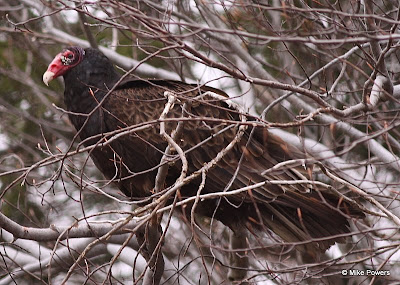The possum was not what first attracted my attention, it was the hulking bird standing in the middle of the road. I slowed to a stop while opening the window. My hopes of watching the bird pluck at a carcass were dashed, but not before I snapped a few shots of a beautiful Turkey Vulture. In my experience it's not often you get that close to one, at least without being vomited on. In the wild they always seem skittish, keeping their distance from observers.
The bird flushed, circled once, and landed in a tangle of branches directly above the possum. Clearly, this bird was not giving up on the possum easily. I captured a few more shots before leaving the bird its morning meal.
As the bird was taking its lap around the field it displayed the diagnostic wing pattern, perhaps the most recognizable field mark of any bird. You can't miss the undersides of the wings as the birds (usually several) circle above you, the leading edge of the wing dark and the trailing edge white, from body to wingtip. Usually those wings aren't flapping, they're held stiff, angled upward from the body in the characteristic dihedral. When it does flap it seems effortless, casual, efficient, and lazy, all at the same time.

This bird reminded me of the wonderment of the feather. Try this: the next time you find a flight feather of any species, preferably one of the long primaries, bend it. It seems stiff, too stiff to flex. It takes a reasonable amount of force to get it to bend, or maybe that just says something about my lack of a weight-lifting routine.

How does the bird bend them so easily? It doesn't seem that the muscles attached to the quill could do that, could the bird do it of its own volition? Or is it something external to the bird, something to do with the flapping motion? So much to learn. And that's the thing about birding, isn't it? There is beauty, wonderment, and a never-ending source of questions to engage you, even watching a bald bird with a red-skinned head stalk a dead animal on the side of the road.
I can't wait for the warblers!
-





2 comments:
Gorgeous shots. I love these birds. Last winter my father and I came across two eating something (too far gone to tell) in the road near his house. One climbed the curb into the grass, but the other just stood and watched as my father pulled wide around him. I wish I'd had my camera.
Good Post and also nice well written blog enjoyed going through ur archives.
Delson
Post a Comment